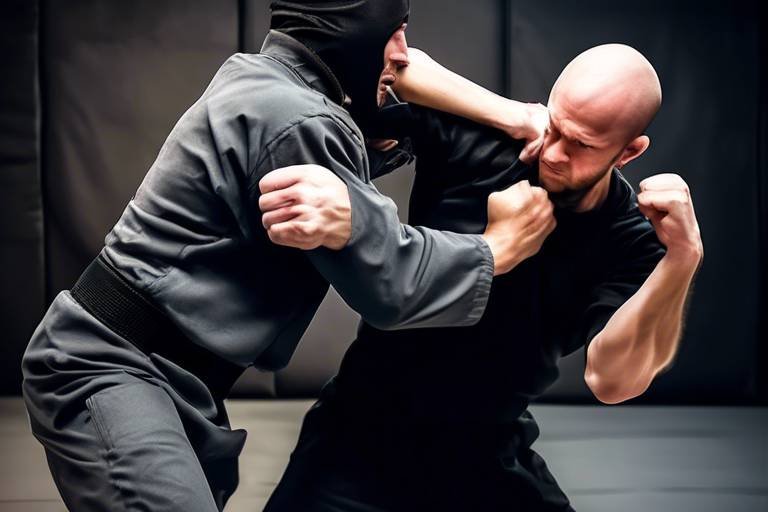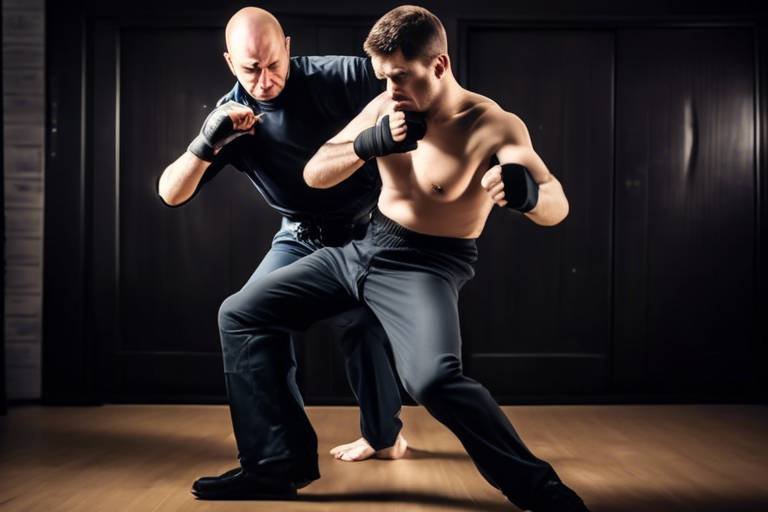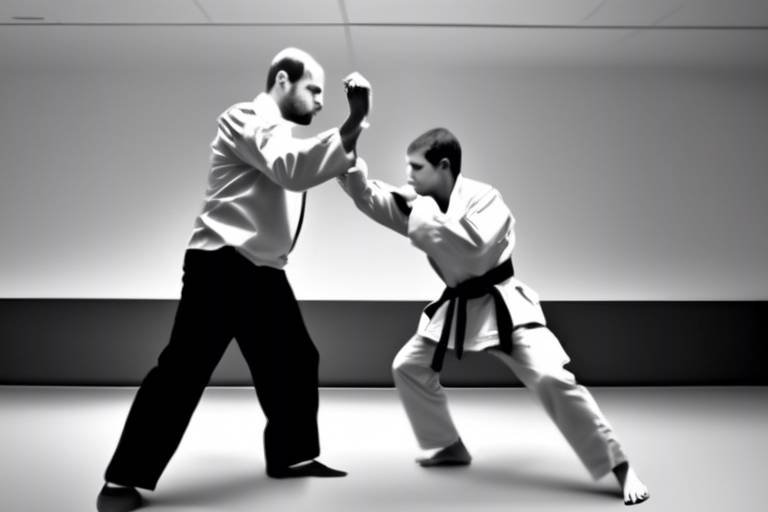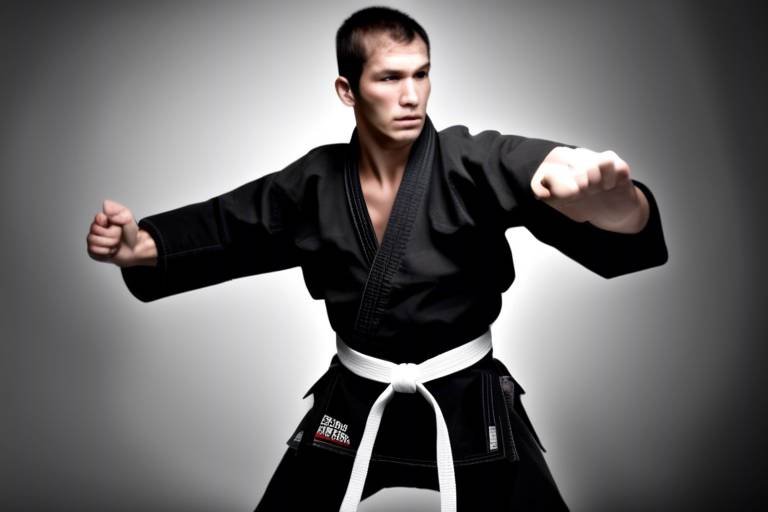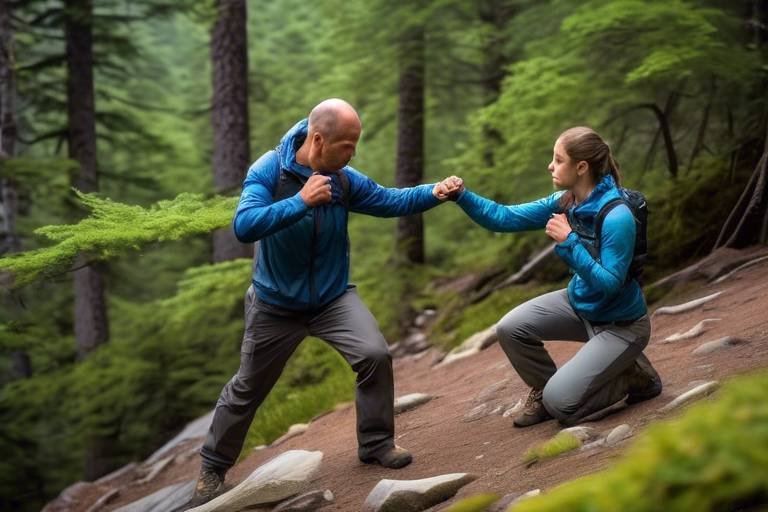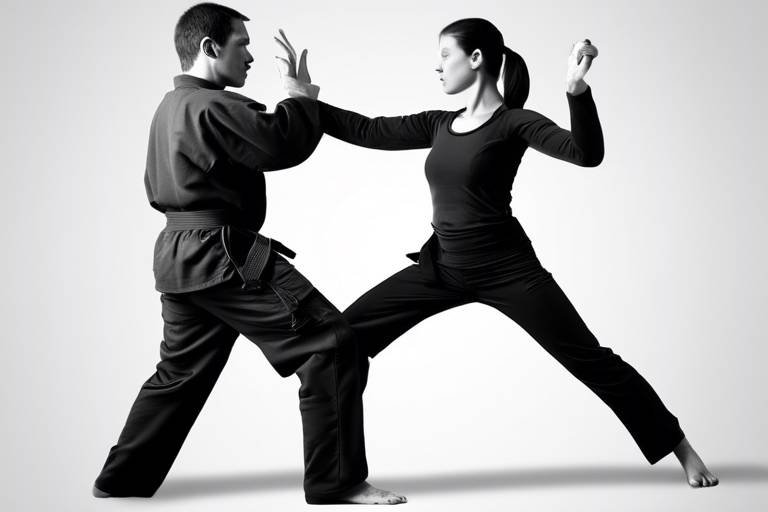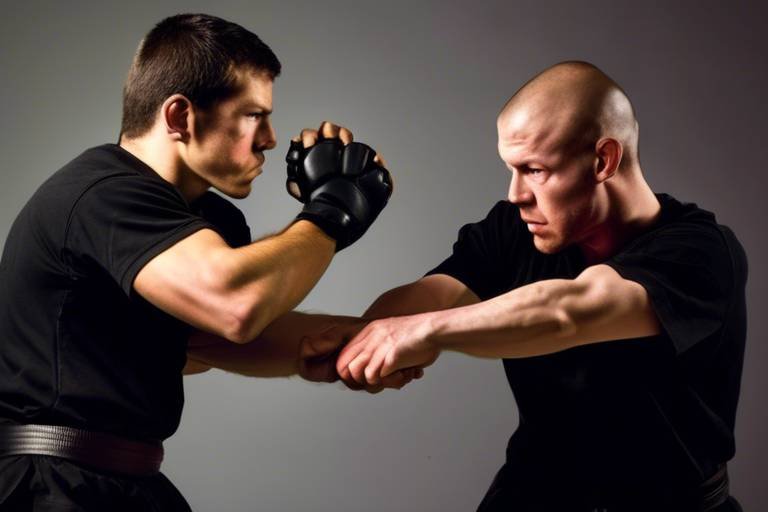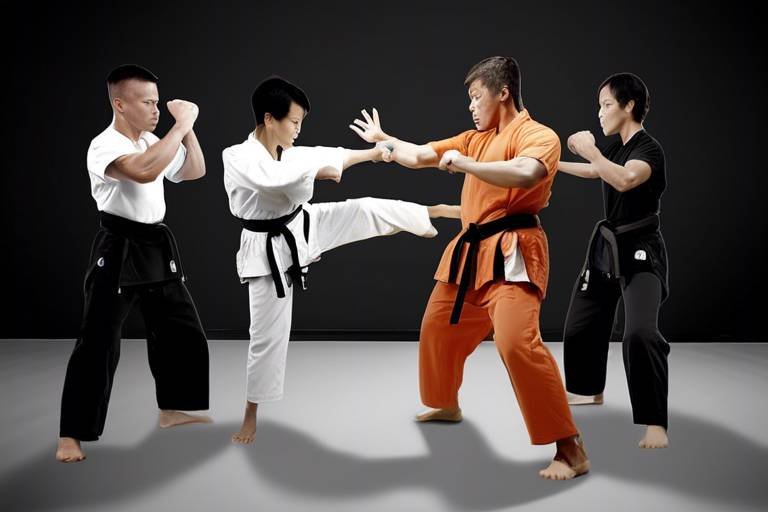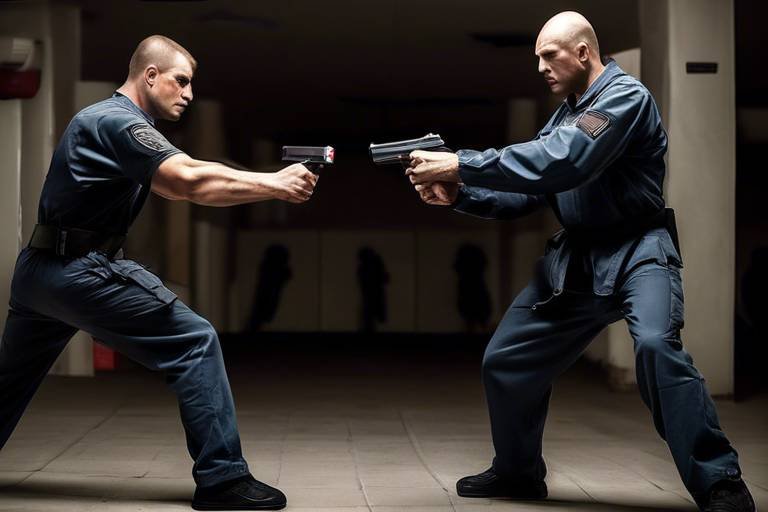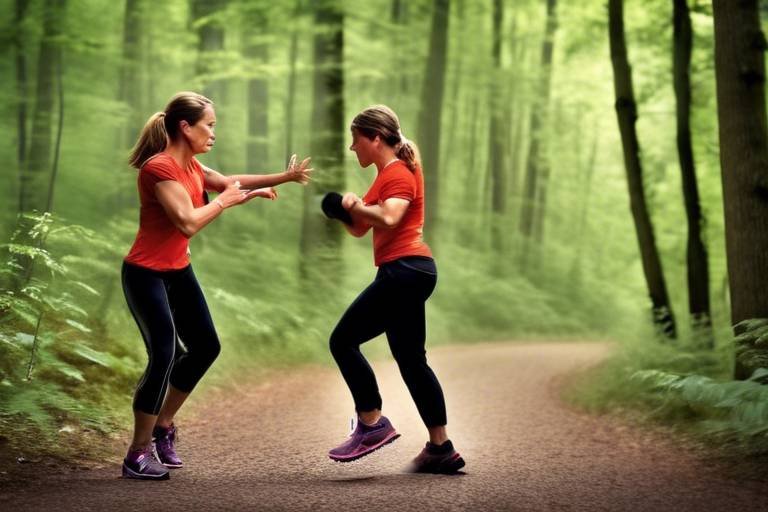Top 5 Self-Defense Techniques that Anyone can Learn and Use
In today's world, where personal safety can sometimes feel like a distant concern, knowing how to protect yourself is more crucial than ever. Self-defense isn't just about fighting back; it's about having the confidence to stand your ground and the skills to escape potentially dangerous situations. This article explores essential self-defense techniques that are accessible to everyone, providing practical skills to enhance personal safety and confidence in various situations.
Self-defense is the art of protecting oneself from harm. It's not just a physical response; it involves mental preparedness and an understanding of your surroundings. The importance of self-defense cannot be overstated—it empowers individuals to take charge of their safety. Not only does it equip you with the skills to defend yourself, but it also cultivates a mindset that is vigilant and proactive. Before diving into specific techniques, it's essential to grasp the legal implications of self-defense. Each jurisdiction has its own laws governing how and when you can defend yourself, and being informed can save you from legal troubles later on. Moreover, having the right mindset is vital. You need to be aware, calm, and ready to react if a situation arises. Think of self-defense as a mental game of chess; the better you understand the rules, the more effectively you can play your hand.
The basic stance is foundational for effective self-defense. Imagine you're a tree, rooted firmly in the ground, ready to sway but not fall. This positioning is crucial for maintaining balance and readiness. Stand with your feet shoulder-width apart, knees slightly bent, and your weight evenly distributed. Keep your hands up, not just to protect your face but also to prepare for any potential strikes. This stance allows you to react swiftly to any threats, giving you the agility needed to evade or counterattack. Remember, a strong stance is like a solid foundation; without it, everything else crumbles. Practicing this stance regularly can help you develop muscle memory, making it second nature when you need it most.
Learning how to escape from various grabs is crucial. Imagine being caught in a bear hug—panic can set in quickly, but knowing how to break free can empower you. There are several methods to escape wrist, arm, and body holds. For instance, if someone grabs your wrist, rotate your wrist towards their thumb, as it's the weakest part of their grip. For a bear hug, drop your weight and shift your body to create space, making it easier to break free. Each of these techniques is designed to empower you, allowing you to regain control in threatening situations. The key is to remain calm and focused. The more you practice these escapes, the more instinctive they will become, turning panic into action.
Striking techniques can deter an attacker effectively. Think of your body as a well-tuned machine—every part has a role to play. We will explore effective punches, kicks, and elbow strikes that can be easily learned and applied. For example, a well-placed jab can create distance, while a swift kick can incapacitate an assailant. It's essential to emphasize precision and timing over brute strength. Just like a skilled archer focuses on their aim, you should focus on your target and the technique rather than the force of your strike. Regular practice will enhance your striking abilities, making you not just a defender but an assertive individual ready to stand up for yourself.
Everyday objects can serve as improvised self-defense tools. Picture this: you're walking down the street, and you notice a suspicious figure approaching. Instead of panicking, you can grab your keys, a pen, or even your bag to defend yourself. This section discusses how to utilize these items effectively. For instance, holding your keys between your fingers can create a makeshift weapon, while a pen can be used to jab at sensitive areas. The beauty of using everyday objects lies in their accessibility; they're always around you. Enhancing your situational awareness and resourcefulness can turn mundane items into lifesavers. Remember, it's not the tool but how you use it that counts.
Ground defense is vital if you're taken to the ground. Imagine being a turtle; when flipped over, your goal is to right yourself as quickly as possible. Here, we will cover techniques to protect yourself while on the ground, including escapes and defensive positions. If you find yourself on the ground, maintain a defensive posture, keeping your arms up to protect your head and face. Use your legs to create distance and push away from your attacker. The ability to regain your footing can be the difference between staying safe and being vulnerable. Practicing ground defense techniques can help you feel more confident in these situations, turning a potentially frightening experience into a manageable one.
Regular practice is essential for muscle memory and confidence. Just like learning to ride a bike, the more you practice self-defense techniques, the more instinctive they become. This section emphasizes the importance of training, whether through classes, drills, or practice with friends. Consider setting up a weekly schedule to practice different techniques, ensuring that you stay sharp and ready. Remember, self-defense isn't just about knowing how to fight; it's about being prepared for any situation that may arise. The more you practice, the more confident you'll feel, and that confidence can deter potential threats even before they happen.
Understanding the legal aspects of self-defense is crucial. Every region has its laws regarding self-defense, and knowing these can help you navigate the complexities of using force in various situations. For instance, many places follow the "reasonable force" doctrine, which means you can only use the level of force necessary to defend yourself. Additionally, it's essential to know when to retreat and when to stand your ground. This section outlines key laws and regulations that govern self-defense actions, helping you make informed decisions in critical moments. Remember, knowledge is your best defense, not just against physical threats but legal ones as well.
Self-defense training not only teaches skills but also builds confidence. Imagine walking into a room full of strangers, knowing you have the ability to protect yourself if necessary. This final section discusses how learning self-defense can empower individuals, fostering a greater sense of safety and self-assurance in daily life. As you master these techniques, you'll find that your confidence spills over into other areas of your life, making you more assertive and self-reliant. The journey of self-defense training is not just about physical skills; it's about transforming your mindset and embracing your inner strength.
- Can anyone learn self-defense? Absolutely! Self-defense techniques can be adapted to suit individuals of all ages and fitness levels.
- How long does it take to learn self-defense? The time it takes to learn self-defense varies, but with consistent practice, you can become proficient in a few months.
- Do I need special equipment to practice self-defense? While some techniques may require gear, many can be practiced with everyday items or even just your body.
- Is self-defense legal everywhere? Laws vary by location, so it's essential to understand the self-defense laws in your area.

Understanding Self-Defense
Self-defense is not just about fighting back; it's an essential skill set that empowers individuals to protect themselves from harm. In a world where unpredictability is the norm, having the ability to defend oneself can be a game changer. Think of self-defense as your personal armor, ready to shield you from potential threats. But what does it truly mean to engage in self-defense? It’s about understanding your environment, recognizing potential dangers, and being prepared to act when necessary.
One of the most critical elements of self-defense is the mindset. You must be aware of your surroundings and trust your instincts. This means being vigilant and recognizing when something feels off. For instance, if you find yourself in a situation that raises alarm bells, your gut feeling is often your best guide. Cultivating this awareness can help you avoid dangerous situations altogether, but if confrontation is unavoidable, knowing how to respond can make all the difference.
Moreover, it's essential to grasp the legal implications surrounding self-defense. Laws vary by location, and understanding what constitutes reasonable force in self-defense situations is crucial. For example, the use of force must be proportional to the threat faced. Engaging in self-defense doesn't give you a free pass to escalate violence; rather, it requires a measured response that aligns with legal standards. Here’s a quick overview of some common legal principles:
| Legal Principle | Description |
|---|---|
| Reasonable Force | The force used in self-defense must be proportional to the threat. |
| Duty to Retreat | In some jurisdictions, you must attempt to retreat before using force. |
| Imminent Threat | Self-defense is justified only if there is an immediate threat of harm. |
Additionally, the importance of awareness and preparedness cannot be overstated. Self-defense isn't just about physical techniques; it also involves mental readiness. Imagine walking down a street, and you notice someone following you. Instead of panicking, your training kicks in, and you assess your options. Do you change your route? Do you find a crowded area? This mental agility is just as vital as knowing how to throw a punch.
In essence, understanding self-defense is about more than just the techniques you learn; it’s about developing a comprehensive approach to personal safety that encompasses awareness, mental readiness, and legal knowledge. This holistic perspective will not only prepare you for potential confrontations but also instill a sense of confidence in your ability to handle various situations. So, as you embark on your journey to learn self-defense, remember that it’s not just about the physical moves; it’s about cultivating a mindset that prioritizes safety and preparedness.

Technique 1: The Basic Stance
The basic stance is the cornerstone of effective self-defense. Think of it as the foundation of a house; without a solid base, everything else can crumble. When you adopt the right stance, you set yourself up for success, allowing for quick movements and reactions. So, how do you find that perfect stance? It’s all about balance, posture, and readiness.
First, stand with your feet shoulder-width apart. This position gives you stability and makes it harder for an attacker to knock you off balance. Next, angle your body slightly to the side. This not only presents a smaller target to potential threats but also prepares you to pivot or move in any direction quickly. Your knees should be slightly bent, ready to spring into action at a moment's notice.
Now, let’s talk about your hands. Keep them up and in front of your face, with your elbows tucked in. This position serves two purposes: it protects your head and allows you to strike or block effectively. Imagine you’re a boxer, poised and ready to defend yourself. Your hands should be relaxed but alert, ready to respond to any sudden movements.
Here’s a quick breakdown of the elements of a solid basic stance:
- Feet Position: Shoulder-width apart for stability.
- Body Angle: Slightly turned to the side to present a smaller target.
- Knees: Slightly bent for readiness.
- Hands: Up and in front of your face, elbows tucked.
Practicing this stance regularly will help you feel more comfortable and confident in your ability to defend yourself. It’s like learning to ride a bike; once you get the hang of it, you can focus on other techniques without worrying about falling over. Remember, the goal is to be prepared, so take a few moments each day to practice your stance in front of a mirror. This will help you internalize the posture and make it second nature when you need it most.
Moreover, understanding how to transition from this basic stance to other techniques is crucial. Whether you need to escape a grab or launch a counter-attack, starting from a solid stance gives you the advantage. Think of it as the launchpad for your self-defense skills; without it, you might find yourself struggling to react in a critical moment.
In summary, the basic stance is not just about standing still; it’s about preparing yourself mentally and physically for whatever may come your way. By mastering this foundational technique, you’re not only enhancing your self-defense skills but also boosting your confidence. So, stand tall, stay alert, and let your basic stance be your first line of defense!

Technique 2: Escaping Grabs
When it comes to self-defense, escaping grabs is a crucial skill that everyone should master. Imagine you're walking down the street, and suddenly someone grabs your wrist or arm. Panic sets in, but knowing how to effectively break free can make all the difference. In this section, we’ll delve into various methods to escape from different types of grabs, empowering you to regain control in threatening situations.
First, let’s discuss the wrist grab. This is one of the most common forms of an attack. If someone grabs your wrist, the key is to remain calm and use your body’s natural mechanics to your advantage. One effective technique is to rotate your wrist towards the attacker’s thumb. Since the thumb is the weakest point of the grip, this movement can create enough space for you to pull your hand away. Picture this: you’re a cork in a bottle, and the thumb is the cap. By twisting, you can easily pop the cork out.
Next, we have the arm grab. This happens when an assailant seizes your arm with both hands. To escape, you can step back with the foot opposite to the arm being grabbed, creating distance while simultaneously pulling your arm away. This technique not only helps you break free but also puts you in a better position to respond. Think of it like a game of tug-of-war; the more you lean back and pull, the stronger your position becomes.
Now, let’s tackle the body hold, where someone wraps their arms around you. This can be particularly frightening, but there are ways to escape. A simple yet effective method is to drop your weight down and turn your body towards the attacker. By lowering your center of gravity, you make it harder for them to maintain their grip. Additionally, using your elbows to strike their arms can create the necessary space for you to break free. Remember, it’s all about using your body’s natural movements to outmaneuver your opponent.
To summarize, here are the key techniques for escaping grabs:
- Wrist Grab: Rotate your wrist towards the attacker’s thumb.
- Arm Grab: Step back and pull your arm away.
- Body Hold: Drop your weight and turn towards the attacker.
Practicing these techniques regularly will not only improve your skills but also boost your confidence. Consider pairing up with a friend or joining a self-defense class to refine your movements. The more you practice, the more instinctive your reactions will become, allowing you to respond effectively in real-life scenarios.
In conclusion, escaping grabs is a vital component of self-defense. By mastering these techniques, you equip yourself with the tools necessary to handle unexpected situations. Remember, it's not just about strength; it's about technique and timing. So, take the time to practice, and you'll find yourself feeling more secure and empowered in your daily life.

Technique 3: Striking Techniques
When it comes to self-defense, striking techniques are your best friends. Think of them as your personal alarm system, designed to deter an attacker and give you the chance to escape. The beauty of striking techniques lies in their simplicity and effectiveness. You don’t need to be a martial arts expert to deliver a powerful strike; you just need to understand the basics and practice them regularly.
First, let's break down some essential striking methods that anyone can learn. These techniques include punches, kicks, and elbow strikes. Each of these strikes can be delivered quickly and with precision, making them ideal for self-defense situations. But remember, it’s not about brute strength; it’s about technique and timing. Just like a skilled musician can create beautiful music with practice, you can become proficient in self-defense strikes with dedication.
Here’s a quick overview of some effective striking techniques:
| Technique | Description | Best Use |
|---|---|---|
| Punch | A direct strike using your fist. | Close-range encounters. |
| Kick | A powerful strike using your leg. | Creating distance from an attacker. |
| Elbow Strike | A short-range strike using your elbow. | In close quarters, when you can't use your fist. |
To execute a punch effectively, focus on your stance first. Stand with your feet shoulder-width apart, knees slightly bent, and your dominant foot slightly back. This position allows you to maintain balance while generating power. When you throw a punch, aim for your target with your knuckles, and remember to keep your other hand up to protect your face. It’s all about that quick jab that can catch an attacker off guard!
Kicking is another fantastic option, especially if you want to create distance between you and your assailant. A well-placed kick can incapacitate an attacker, giving you the time you need to escape. For beginners, the front kick is a great choice. Raise your knee, extend your leg forward, and aim for the attacker's knee or groin. This technique not only helps you defend yourself but also puts you in a position to flee.
Now, let’s not forget about the elbow strike. This technique is particularly useful in close-quarters situations where you might not have the space to throw a punch. By driving your elbow into the attacker's face or body, you can create a significant impact. Just remember, the key is to stay calm and focused. Think of it like a game of chess; you need to anticipate your opponent's moves and react swiftly.
Incorporating these striking techniques into your self-defense repertoire can significantly boost your confidence. It’s essential to practice them regularly, either in a class or with a training partner. The more you practice, the more natural these movements will become, and the better prepared you'll be in a real-life situation. So, grab a friend, hit the gym, or even shadowbox at home to hone your skills!
In conclusion, striking techniques are not just about throwing punches and kicks; they are about understanding your body, maintaining balance, and knowing when to act. With practice, patience, and the right mindset, you can master these techniques and enhance your personal safety. Remember, self-defense is as much about mental preparedness as it is about physical skills.

Technique 4: Using Everyday Objects
When it comes to self-defense, the idea that you need specialized weapons or advanced training can often feel overwhelming. However, the truth is that many of the items we carry every day can be transformed into powerful self-defense tools. Think about it: your keys, pen, or even a bag can serve as effective means of protection in a pinch. This technique emphasizes the importance of being resourceful and aware of your surroundings, enabling you to utilize whatever is at hand to defend yourself.
Imagine walking down a dimly lit street and suddenly finding yourself in a potentially dangerous situation. Instead of panicking, you can reach for your keys. Holding them between your fingers can create a makeshift weapon that can inflict pain if used correctly. Similarly, a pen can be a surprisingly effective tool for self-defense. With a firm grip, it can be used to jab at an attacker's pressure points, giving you a chance to escape. The key here is to practice how to wield these everyday objects confidently and effectively.
Moreover, your bag can also play a vital role in self-defense. Whether it’s a backpack or a handbag, swinging it towards an attacker can create distance and deter them from approaching. Additionally, if you find yourself on the ground, your bag can be used as a shield or barrier, buying you precious seconds to regain your footing and escape.
It's essential to integrate these techniques into your daily routine. Here are a few tips on how to practice using everyday objects for self-defense:
- Awareness: Always be mindful of your surroundings and the items you have with you.
- Practice: Regularly practice the techniques of using these objects. For example, simulate a scenario where you need to use your keys or pen for defense.
- Role-Playing: Engage with a friend or family member to role-play different situations, allowing you to react instinctively.
In conclusion, the ability to use everyday objects for self-defense not only enhances your safety but also empowers you with the knowledge that you don't need specialized tools to protect yourself. By staying aware and practicing these techniques, you can turn ordinary items into extraordinary means of defense, ensuring that you are always prepared for the unexpected.

Technique 5: Ground Defense
When it comes to self-defense, many people often overlook the importance of ground defense. Imagine being knocked down during a confrontation; it can feel like the world is closing in on you. However, understanding how to protect yourself while on the ground is crucial. Ground defense techniques not only help you stay safe but also empower you to regain control of the situation. The key is to remain calm and focused, even when you find yourself in a vulnerable position.
One effective method of ground defense is to maintain a strong defensive posture. This involves positioning your body in a way that protects vital areas while allowing you to respond to an attack. For instance, keep your knees bent and your feet flat on the ground, creating a stable base. This stance not only helps you absorb any incoming force but also prepares you for a swift escape or counterattack.
Another essential technique is learning how to create distance. If you’re on the ground and an attacker approaches, it’s vital to push them away using your legs. Think of your legs as a powerful spring; when you push off the ground, you can create enough space to either escape or prepare for a counterstrike. A well-timed kick can surprise your assailant, giving you the chance to get back on your feet.
Additionally, mastering the art of rolling can be a game changer. When you fall, rolling can help distribute the impact and reduce the risk of injury. Practicing rolls can also prepare you for quickly transitioning into a more advantageous position. For example, if you find yourself on your back, rolling to the side can help you escape from an attacker’s grasp or prepare to strike back.
Here are some key ground defense techniques you should practice:
- Guard Position: Keeping your knees up and your hands ready to defend against strikes.
- Hip Escape: A technique to create space by moving your hips away from the attacker.
- Technical Stand-Up: A method to get back on your feet safely while maintaining a defensive posture.
Practicing these techniques regularly will not only enhance your skills but also build your confidence. Remember, the goal of ground defense is not just to survive but to regain control and escape effectively. It's about turning the tables and using the element of surprise to your advantage.
In conclusion, ground defense is an essential component of self-defense training. By understanding how to protect yourself while on the ground, you can significantly increase your chances of escaping a dangerous situation. So, don’t underestimate the power of ground techniques; they could be your ticket to safety in a critical moment.
Q1: What should I do if I find myself on the ground during an attack?
A1: Stay calm, protect your vital areas, and look for opportunities to create distance or escape. Use your legs to push the attacker away if possible.
Q2: How can I practice ground defense techniques?
A2: Consider joining self-defense classes or practicing with a partner. Regular drills will help you build muscle memory and confidence.
Q3: Are ground defense techniques effective against larger attackers?
A3: Yes, ground defense techniques focus on leverage and timing, which can help you defend against larger opponents effectively.
Q4: Do I need special training to learn these techniques?
A4: While formal training can be beneficial, many ground defense techniques can be learned through practice and guidance from experienced individuals.

Practicing Self-Defense Techniques
When it comes to self-defense, practice makes perfect. Just like learning to ride a bike or play a musical instrument, the more you practice, the more instinctive your reactions become. Regularly practicing self-defense techniques not only helps you build muscle memory but also boosts your confidence in handling real-life situations. Imagine being in a challenging scenario; wouldn’t it be reassuring to know that your body can respond automatically without overthinking?
One of the best ways to practice is by enrolling in self-defense classes. These classes typically offer structured training, allowing you to learn various techniques while receiving immediate feedback from an instructor. Plus, training with others can create a supportive environment where you can push each other to improve. If classes aren’t an option, consider gathering a group of friends for practice sessions. This way, you can practice various techniques and simulate real-life scenarios in a safe setting.
In addition to classes and group practice, you can also incorporate self-defense drills into your daily routine. For instance, set aside a few minutes each day to practice specific moves, such as escapes from grabs or striking techniques. This not only reinforces your skills but also keeps you physically active. You might even find that these drills become a fun part of your day!
Remember, the key to mastering self-defense techniques is consistency. Just like any skill, self-defense requires ongoing practice to remain effective. As you continue to train, you’ll notice improvements in your agility, strength, and reaction time. It’s essential to make self-defense a regular part of your life, so it becomes second nature. In the end, the goal is to feel empowered and ready to defend yourself when it matters most.
Additionally, consider incorporating visualization techniques into your practice. Picture yourself in various scenarios, mentally rehearsing how you would respond. This mental practice can be just as beneficial as physical training, as it prepares your mind to react calmly and decisively in stressful situations.
To help you track your progress, you might want to keep a practice journal. Documenting your sessions can provide insight into what techniques you excel at and which ones need more work. You can also set specific goals for each practice session, whether it’s perfecting a particular move or increasing your reaction speed. This structured approach can help keep you motivated and focused.
In summary, practicing self-defense techniques is crucial for developing the skills needed to protect yourself. Whether through classes, group sessions, or solo drills, the more you practice, the more confident and capable you will become. So, lace up your shoes, grab a partner or head to a class, and start honing those self-defense skills today!
- How often should I practice self-defense techniques? Aim for at least 2-3 times a week to build muscle memory and confidence.
- Can I practice self-defense alone? Yes, many techniques can be practiced solo, but working with a partner can enhance your training.
- Do I need special equipment to practice? While some techniques may require mats or pads, many can be practiced with minimal or no equipment.
- What if I don’t have access to classes? You can find numerous online resources, videos, and tutorials to help you practice at home.

Legal Considerations in Self-Defense
When it comes to self-defense, understanding the legal implications is as crucial as mastering the techniques themselves. You might think that defending yourself is a straightforward matter, but the law can be a bit of a maze. It’s essential to know your rights and the boundaries of acceptable self-defense in your jurisdiction. After all, you want to protect yourself without landing in legal trouble, right?
First and foremost, the concept of self-defense typically revolves around the principle of proportionality. This means that the level of force you use in self-defense must be appropriate to the threat you are facing. For example, if someone is merely pushing you, responding with lethal force would likely be considered excessive and could lead to serious legal consequences. It's like using a sledgehammer to crack a nut—overkill!
Another critical aspect to consider is the immediacy of the threat. Self-defense laws generally allow you to use force only when you are in imminent danger. If the threat has passed or if you have the opportunity to retreat safely, using force may not be justified. Think of it this way: if someone yells at you from across the street, you can’t just charge at them with a baseball bat. The law expects you to act rationally and responsibly.
Different states and countries have varying laws regarding self-defense, so it’s vital to familiarize yourself with the regulations in your area. For instance, some places have “Stand Your Ground” laws, which allow individuals to use force without retreating, while others have a “duty to retreat” requirement. Here’s a quick comparison:
| Jurisdiction | Stand Your Ground | Duty to Retreat |
|---|---|---|
| Florida | Yes | No |
| California | No | Yes |
| Texas | Yes | No |
Additionally, it’s important to keep in mind that self-defense laws often apply differently depending on whether you are defending yourself in your home or in public. Many jurisdictions recognize the “Castle Doctrine,” which allows individuals to use force to protect themselves in their own homes without the obligation to retreat. This principle can offer a sense of security, knowing that your home is your sanctuary.
Lastly, documenting the incident can play a significant role in legal proceedings. If you ever find yourself in a situation where you had to use self-defense, gathering evidence—such as taking photos of injuries, collecting witness statements, or even recording the event if safe to do so—can help establish your case later. Remember, the goal is to show that your actions were justified and necessary.
In summary, while the instinct to protect yourself is natural, being informed about the legal considerations of self-defense can save you from future headaches. Always prioritize understanding the laws in your area, act proportionately, and document everything if you ever need to defend your actions in court. This knowledge not only empowers you but also ensures you navigate the complexities of self-defense with confidence.
- What should I do immediately after a self-defense incident? Document everything, seek medical attention if needed, and contact legal counsel.
- Can I use self-defense if I was the one who initiated the confrontation? Generally, self-defense applies only if you were in imminent danger, but specific circumstances can vary.
- Do I need to report a self-defense incident to the police? Yes, it’s advisable to report the incident to ensure there’s a formal record of what happened.

Building Confidence Through Self-Defense
Learning self-defense is not just about mastering techniques; it's also a powerful way to boost your confidence. Imagine walking down the street and feeling a sense of empowerment, knowing you can handle yourself in a tough situation. That’s the magic of self-defense training! It’s like adding a protective layer to your personality, making you feel more secure in your surroundings.
When you engage in self-defense classes, you’re not just learning how to throw a punch or escape a hold. You’re also developing a stronger mindset. Each technique you practice builds your resilience and sharpens your awareness. It’s akin to training for a marathon; the more you practice, the stronger and more capable you become. As you progress, you’ll find that your fears diminish and your self-assurance grows. You may even surprise yourself with what you can achieve!
Moreover, self-defense training often fosters a sense of community. When you train with others, you’re surrounded by like-minded individuals who share similar goals. This camaraderie can further enhance your confidence as you support one another through challenges. You learn not just from instructors but also from your peers, creating a rich learning environment. Think of it as a team sport where everyone cheers for each other’s victories, no matter how small.
Another significant aspect of building confidence through self-defense is the realization that you have the ability to protect yourself. This realization can be life-changing. It shifts your perspective from feeling vulnerable to feeling empowered. You start to recognize that you have options and that you can make choices that prioritize your safety. This newfound awareness can seep into other areas of your life, influencing how you approach challenges and obstacles.
In addition to physical skills, self-defense training often incorporates mental strategies. For instance, you learn to assess situations, identify potential threats, and react calmly under pressure. This mental fortitude is invaluable, not just in self-defense scenarios but in daily life. You become more decisive and assertive, qualities that are essential in both personal and professional settings.
To sum it up, building confidence through self-defense is a multifaceted journey. It involves physical training, mental preparation, and community support. So, whether you’re a complete novice or someone looking to refine your skills, remember that every step you take in self-defense training is a step toward greater confidence and empowerment. Why not take that leap today? Your future self will thank you!
- Do I need to be physically fit to start learning self-defense?
No, self-defense techniques can be learned by anyone, regardless of fitness level. The focus is on technique and strategy rather than strength. - How long does it take to become proficient in self-defense?
Proficiency varies by individual, but regular practice and commitment can lead to noticeable improvement in a few months. - Is self-defense training safe?
Yes, reputable self-defense classes prioritize safety and teach techniques in a controlled environment. - Can self-defense training help with anxiety or fear?
Absolutely! Many individuals find that self-defense training helps reduce anxiety and builds overall confidence.
Frequently Asked Questions
- What is self-defense?
Self-defense is the practice of protecting oneself from physical harm. It involves techniques and strategies that allow individuals to defend against an attacker, ensuring personal safety in dangerous situations.
- Can anyone learn self-defense techniques?
Absolutely! Self-defense techniques are designed to be accessible to everyone, regardless of age, size, or fitness level. With practice and dedication, anyone can learn to effectively defend themselves.
- How important is the basic stance in self-defense?
The basic stance is crucial as it provides a solid foundation for all self-defense techniques. A good stance helps maintain balance and readiness, allowing you to react quickly to threats.
- What should I do if someone grabs me?
If someone grabs you, it’s essential to stay calm and use specific techniques to escape. Learning how to break free from various holds can empower you to regain control of the situation.
- Are striking techniques effective for self-defense?
Yes! Striking techniques, such as punches and kicks, can be very effective in deterring an attacker. The key is to focus on precision and timing rather than just brute strength.
- Can everyday objects be used for self-defense?
Definitely! Everyday objects like keys, pens, or even your bag can be used as improvised self-defense tools. Being resourceful and aware of your surroundings can enhance your safety.
- What if I end up on the ground during an attack?
If you find yourself on the ground, knowing ground defense techniques is vital. These techniques can help you protect yourself and find a way to escape or regain your footing.
- How often should I practice self-defense techniques?
Regular practice is essential for building muscle memory and confidence. Whether through classes, drills, or practice with friends, consistent training will prepare you for emergencies.
- What are the legal implications of using self-defense?
Understanding the legal aspects of self-defense is crucial. Laws vary by location, so it's important to know what constitutes reasonable force in your area to navigate any potential legal complexities.
- Can self-defense training boost my confidence?
Absolutely! Learning self-defense not only equips you with practical skills but also fosters a greater sense of safety and self-assurance in everyday life. It’s empowering!

